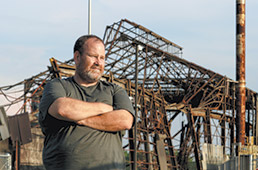Subscriber Benefit
As a subscriber you can listen to articles at work, in the car, or while you work out. Subscribe NowIn sheer numbers, the Indianapolis economy has replaced thousands of jobs lost to automation, offshoring and the Great Recession.
But many of the jobs that have flourished in their place can’t support a family and are often impossible to reach without a car.
 Gone are lucrative manufacturing positions that could elevate a family into the middle class, even without higher education.
Gone are lucrative manufacturing positions that could elevate a family into the middle class, even without higher education.
Those jobs were in city neighborhoods. They offered salaries high enough to pay for homes, send kids to college, and build up savings accounts.
And there were tons of them. At their peaks, the General Motors stamping plant employed 5,600 people, Western Electric had 8,000 workers, and RCA had 8,200.
But today, scattered brownfields—some with crumbling buildings, some vacant lots—are the only remnants of those once-bustling factories.
The workers, though, remain. And increasingly, they’re experiencing a local economy that doesn’t work for them.
 Klitzsch
Klitzsch“The better jobs, there’s not enough of them,” said Angela Carr Klitzsch, CEO of EmployIndy, Marion County's workforce development board. “Even if we had all the money in the world for training, and understood where the demand was, and everyone wanted to work, there still wouldn’t be enough jobs in that sweet spot.”
That “sweet spot” is essentially $18 an hour, a wage that’s generally enough for self-sufficiency—although Klitzsch said that can fluctuate depending on someone’s family situation.
“That is just breaking even, not saving or having assets,” she said.
Lower-paying jobs abound in the metro area, namely in the service industry and in distribution centers on the outskirts of the city and in the suburbs. The median pay of a warehouse worker in the Indianapolis area is $13.46 an hour, according to the crowdsourced salary site payscale.com.
But even those jobs are farther away—and harder to get to—than the factories that used to sit in Indianapolis neighborhoods.
Story continues below.
Working but homeless
Stefanie Bell and Steven Pedrazoli—and their 8-year-old son, Chance—are living that new reality.
Both parents have regularly worked, but the family is homeless. They’ve been living since April at Dayspring Center at 1537 Central Ave.
Bell, 37, a server, has uncertain wages because she relies on tips and a $2.13 hourly wage that barely covers taxes. During some shifts, the money at Primanti Bros. restaurant downtown is good. During others, factoring in $3.50 for a round-trip IndyGo bus fare, it’s barely worth showing up. The night before meeting with IBJ, Bell made just $30 in tips, despite working 5 p.m. to close.
Pedrazoli, 36, who until recently worked in the kitchen at Primanti Bros. and has worked in distribution centers around the area, has struggled to keep a job because of the family’s child care needs. After one-too-many babysitting scheduling mishaps, “it just got to the point [at Primanti] where they needed somebody reliable.”
Both long for self-sustainability—full-time jobs, a home, a stable life for Chance.
“He asks when we’re going to get a place, when he’s going to have his own room,” Bell said, her eyes welling with tears. “Our only answer is, ‘We’re working for it. That’s why Mom’s never home.’ That’s my answer. It gets hard when I see him for 30 minutes before school and 20 minutes before I leave for work at night.”
But Pedrazoli and Bell don’t want to get a place only to lose it again. A two-bedroom apartment in a safe area of town will cost $700 to $900 a month, Bell estimates, not including utilities, food and the rest of life’s necessities.
And transportation struggles are holding them back. The couple’s car broke down and was towed before they could afford to get it fixed. Inside were Pedrazoli’s work shoes.
So for now, they’re relying on the bus.
Bell said she and Pedrazoli know distribution centers in Plainfield offer decent-paying jobs. But the IndyGo bus service is spotty that far from the city center, and even if it’s going to the right place, it stops running late at night, making it unusable for working third shift.
Pedrazoli said he is looking for work, he hopes in warehousing or manufacturing, where “the pay is usually better.” His long-term goal is to get his high school equivalency degree.
“I would like a career, not just a job,” Pedrazoli said. “Something I can count on. I don’t know where to start.”
Bell has a degree as a medical assistant—the occupation she would like to find work in, a path she hopes would lead to becoming a registered nurse. But she needs refresher courses after being out of the field since her son was born, leaving her stuck between improving her life long term and needing money to survive short term.
“People in our situation are kind of looked down upon,” Bell said. “They feel we’re trying to live off the system. I would much rather be self-sustaining and not needing any support. This can happen to anybody. I was not going to let my son live on the streets. At that point, you have to swallow your pride.”
Story continues below.
Underemployment
Their family’s situation is far from unique in Indianapolis, where many people work but remain poor and others have simply given up trying.
Consider the following from the U.S. Census and U.S. Bureau of Labor Statistics:
◗ More than 40 percent of those living in poverty in Indianapolis are working.
◗ Nearly half the city’s ZIP codes have unemployment rates in the double digits.
◗ Almost a third of Indianapolis residents over age 16 aren’t even participating in the labor force—meaning they aren’t working or looking for work. This includes full-time caregivers, retirees, people who can’t work for health reasons, and those who have given up looking for a job.
EmployIndy’s Klitzsch said officials love to tout the state’s low unemployment rate and talk about the myriad unfilled jobs that need workers, but she said the reality is more complicated.
The low labor-force-participation rates in some parts of the city (in the downtown ZIP code of 46204, just 49 percent of those 16 or older are working or looking for work) mean available jobs aren’t luring workers.
“It’s very different than where we were 10 years ago,” Klitzsch said. It used to be that the low labor-force-participation rate was a symptom of the recession.
“This number now to me represents those who are choosing not to work because it doesn’t make sense given the wages,” she said. “It’s telling you that no job is better than a job making $10 or $11 an hour, where I might lose some of my benefits, where I have to incur the cost of travel.”
It used to be different here.
“If you were willing to show up and work hard, you could work on the factory floor for 30 years at the relative income of $30 an hour with a pension,” said Indy Chamber Vice President Mark Fisher, whose grandfather did just that at the International Harvester plant, later Navistar, on Brookville Road.
Danny Ernstes, a longtime employee and union leader at the now-shuttered Navistar factory, said “that plant was built to build the nation.” At its peak, Indy Chamber estimates, 4,450 people worked there. Through the decades, the factory built everything from farm implements to refrigerators, in later years making diesel engines.
 Danny Ernstes, 55, said the loss of manufacturing jobs has been “like a death” for those affected. Ernstes worked at the Navistar factory and now is an international representative for the United Auto Workers. (IBJ photo/Lesley Weidenbener)
Danny Ernstes, 55, said the loss of manufacturing jobs has been “like a death” for those affected. Ernstes worked at the Navistar factory and now is an international representative for the United Auto Workers. (IBJ photo/Lesley Weidenbener)“Jobs like that raised families, raised generations, and were part of the culture,” Ernstes said. “They put a lot of kids through college; they paid the bills. When it went away, a whole world went away behind it.”
Navistar’s manufacturing plant closed in 2009 and its foundry closed in 2015.
The closing didn’t just hit people’s wallets. It hit their psyches.
Ernstes, 55, a Navistar employee for 22 years, saw the economy transition firsthand, when the plant closed down and now as an international representative for the United Auto Workers. During his career, he’s helped people retrain, find new jobs, and transition into retirement.
“Losing a job like that is a life-changing thing,” Ernstes said. “It’s like a death.”
Though much of the attention is now on trying to redevelop those shuttered plants, Ernstes said there’s not enough focus on the people who were displaced and the future generations who won’t have access to the same good-paying job options.
“When you drive through here and see the empty plants, it makes your mind wander,” he said. “How have people survived? What have we done for communities that have been devastated?”
 Casson
Casson‘Not always a livable wage’
Lori Casson, who has run the Dayspring homeless shelter for 13 years, said most of the families who find themselves at the shelter are actually working.
“People are shocked to learn that,” Casson said. “It’s not as simple as working harder or working longer.”
The issue is that too many families who work low-paying jobs are just one emergency away from an untenable situation for which they need Dayspring’s help. Before arriving at the shelter, most families were spending 80 percent to 90 percent of their income on rent and utilities, she said.
“So you can imagine, you miss one day of work and you’re behind the eight ball,” Casson said.
And although most of the residents at Dayspring want to gain more skills, get a GED degree or get trained for a better job, there’s a big cost to doing so, even if the training is affordable: lost time without an income.
“Can I really take off six months or three months while I learn the trade? How do I pay my rent? How do I feed my children?” Casson said. They see that the goal is beneficial, she added, but in the short term, they don’t know how to make ends meet.
 Howe
HoweMichael Howe, CEO of the Community Alliance of the Far Eastside, spends his days helping people find jobs that pay more than their current jobs of $9, $10 or $11 per hour.
“You can’t maintain a household, a family, a mortgage, car payments on $10 an hour,” Howe said. “It’s just not mathematical. It doesn’t work out.”
He usually can find a client something in the $12-an-hour range. The ideal is to get clients into jobs that pay at least $15 per hour.
“Still, that’s not always a livable wage,” Howe said.
And when superior jobs—those with higher wages, benefits, health insurance and 401(k)s—do come up?
“Obviously, the cream of the crop get those jobs and people who don’t have the skills or education or background immediately get overlooked,” Howe said.
Another challenge is that many of the better jobs have gravitated to the suburbs and outlying counties—a huge hindrance for people without cars.
The number of jobs available near the average Indianapolis-area resident dropped nearly 11 percent from 2000 to 2012, according to Brookings Institution data. Brookings defines “near” as within a typical commute distance, which is about nine miles in Indianapolis.
In high-poverty neighborhoods, the number of nearby jobs dropped nearly 24 percent.
In fact, of 96 metro areas Brookings measured, Indianapolis had the 77th-worst drop in nearby jobs.
“The spatial mismatch is a huge concern, particularly because we don’t have a robust public transportation system,” EmployIndy’s Klitzsch said.
Employers need people, she said. “They could come from the neighborhoods we prioritize, but there’s just no way to get them there,” she said. “They used to be able to walk down the street to jobs. That’s a problem.”
 Fisher
FisherFisher of the Indy Chamber said Indianapolis has sites available to attract those businesses, but many are contaminated brownfields.
“Companies looking to invest are largely nervous about the uncertainty of investing in an old industrial facility in the heart of the city,” he said. “So they are always looking at greenfield development outside of the city’s core, without considering transportation and workforce housing.”
Fisher said economic development agencies frequently get calls from warehouses in Plainfield and Whitestown that are looking for workers.
“If you continue to build up in those outer rungs, and a year in you can’t find the workforce you need, you need to think of that [like] anything else in your supply chain,” Klitzsch said. “It’s not always considered.”
‘A fraction’
City leaders are trying to focus on the ABC method of helping people move up the economic ladder. First you take any job. Then you get a better job. Then you move into a career.
Employers, though, need to be partners on that ladder—especially the employers that complain about labor shortages, advocates for the poor say.
 Orr
OrrTom Orr, a senior program officer for the Local Initiatives Support Corp., helps oversee seven Centers for Working Families across the city—including the one at the Community Alliance of the Far Eastside. They are largely funded by United Way of Central Indiana.
Orr said that, over the past year, the centers have enrolled more than 3,700 people in one-on-one coaching services, which he said amounts to serving “a fraction of the need that is out there.” The coaches’ job is to help peel back the onion of a person’s situation and provide intensive support.
But they’re also conversing with employers to try to connect businesses with workers.
There have been some successes, Orr said. However, he recently talked with HR staffers from one of the big Indianapolis hospitals who complained about having a talent shortage but also admitted they didn’t engage much with low-wage workers.
“The person delivering a meal to a patient’s room, do they have the aptitude to do something more, like becoming a radiology tech or a surgical tech?” Orr said. “Why don’t you put them on that pathway? [The employers are] open, but they haven’t really thought about how to do it.”
“You’ve got people walking along the corridors sweeping floors every day,” Orr said. “What are the opportunities for them?”•
Story continues below.
Please enable JavaScript to view this content.

